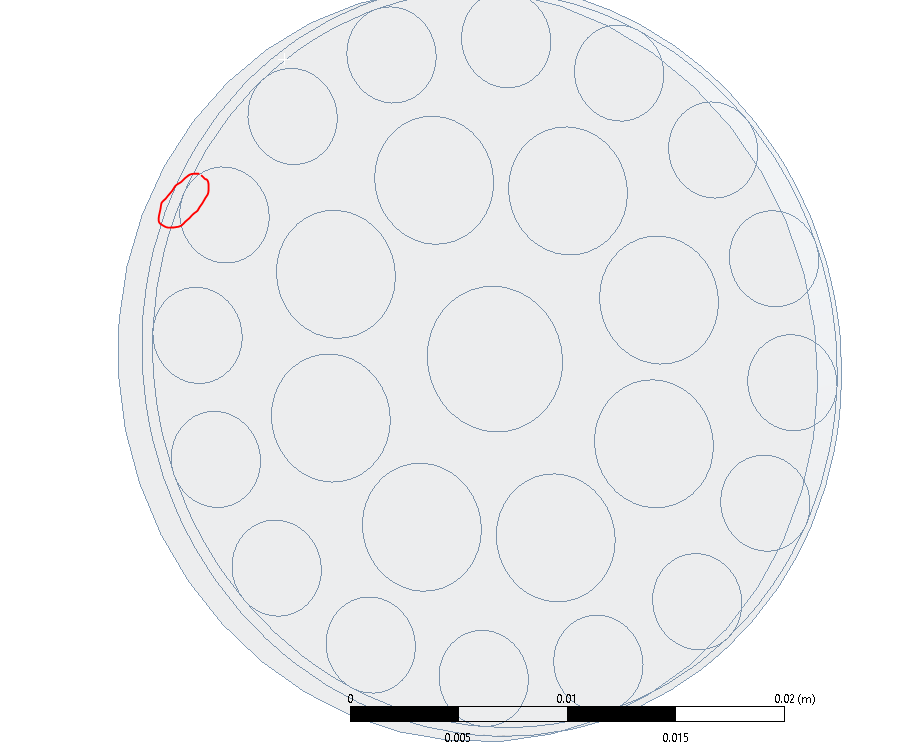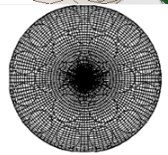-
-
January 23, 2024 at 4:47 pm
Anthony Bowers
SubscriberHi all, I am working on a single-phase flow conditioner simulation. I want to create a good mesh of the part below. I have imprinted the faces of the flow conditioner holes onto the consecutive parts which allow me to name that surface as a wall ( As shown in the green) . I want the holes , that i imprinted, to then be removed or be ignored by the mesh... my goal is to have a mesh as shown below. As you can see the faces of the flow conditioner holes are still there but the mesh ignores the edges
-
January 24, 2024 at 5:53 am
Keyur Kanade
Ansys EmployeeCan you please elaborate more. The green face you showed in the image is very easy to mesh for Mesher and it should not ignore edges of this face. Did you give Named Selection? Please go through help manual for more details
Please check following videos
Ansys Meshing Sizing:
https://www.youtube.com/watch?v=w4q6q8nKF3UDM Share topology:
https://www.youtube.com/watch?v=IO4ZtwZdD2IAnsys Meshing: Meshing Methods:
https://www.youtube.com/watch?v=nEOC8rDnnRoAnsys Meshing: Inflation:
https://www.youtube.com/watch?v=lrEHXizrhC0Regards,
Keyur
How to access Ansys Online Help Document
Guidelines on the Student Community
Fluids Engineering Courses | Ansys Innovation Courses
-
January 25, 2024 at 8:53 am
NickFL
SubscriberIt looks like you are on the right track. The green face may have some trouble because the outer circles are very close perimeter of the green faces. This is due to the round on the lower "body". If I was doing the simulation I would remove this round unless you have deemed this a critical area. The elements in that region could become highly skewed. -
January 29, 2024 at 9:35 pm
-
January 30, 2024 at 7:56 am
NickFL
SubscriberWhy do you not like the mesh that is there? What jumps out at me is that there is no inflation layer which is necessary to capture the sharp gradients within the boundary layer. Also you have a large jump in mesh size from the hex to the tets. You may want to apply some bias to the hex elements so there isn't a big jump. Do you want a conformal mesh between the two mesh types?
Based upon your inquiry I expect you (or your professor) would like hex elements through these tubes. Hex elements will generally require less number of cells and be faster and more accurate for the same number of tet cells. Yes the body is simple enough that you could create a fully hex mesh for it. But it may take you 8 hours to decompose and get the mesh that you want. If you compare this to a tet mesh it may save you 8 hours (likely less) of compute time. But whose time is more valuable, yours or the computer?
I said that it would be possible to create a pure hex mesh, so how would you go about it? The first thing I would do is to remove the rounds as it looks like you only have one element through it anyways. This will help the mesher (and yourself) a lot. Then in ANSYS meshing you can use the multizone method to create a pure hex mesh. Compare the two pictures below. This is for without (upper) and with (lower) rounds. Due to the size of the round the mesh size is shrunk and the result is a huge number of elements (500000+ vs 23000). Also the lower image shows the mesh has some difficulty with the blocking on the several of the tubes and thus would require some babysitting.
-
-
January 30, 2024 at 11:54 am
Rob
Forum ModeratorThanks Nick. I know you know what you're doing, but a comment for the OP to think about. For a good mesh you must also consider that the cell resolution and growth are suitable for flow separation. A pure hex mesh in the above may be overly refined in the far field if you resolve the separation or too coarse in the separation region if you mesh for the far field.
Or look at Fluent Meshing and use polyhedral elements. Most of the benefits of hex with most of the benefits of tet mesh. Having historically decomposed for pure block hex because I had to I'm far more likely to take the "easy" option now I can.
-
January 31, 2024 at 8:23 am
NickFL
SubscriberRob wrote:
Thanks Nick. I know you know what you're doing, ...
I am glad one of us thinks that???? I should have stated that neither of those meshes are adequate, but wanted to show the influence of the rounds and the power of the MultiZone method.
-
January 31, 2024 at 9:32 am
Rob
Forum ModeratorNo further comment.... ;)
-
-
-
January 30, 2024 at 4:25 pm
Anthony Bowers
SubscriberThis al all very helpful thank you. I applied some advice and it partially worked. I was able to he get hexidomanint cells for the individual Flow conditoenr holes, but now the other section is giving me issue. What do you guys suggest for meshing this part? As you can see by the red circle there is a very very small gap between this edge and the flow conditoner edge..
-
January 30, 2024 at 4:32 pm
-
January 30, 2024 at 5:06 pm
Rob
Forum ModeratorHard to tell from the image, but my guess is it's a hex block mesh, so possibly ICEM Hexa and an excessively large amount of time doing decomposition. There's a reason CFD solvers moved from i j k block meshes to the fully unstructured codes of today.
Re the gap - I'd remove the chamfer as Nick suggests or look into pinch control (Ansys Meshing).
-
January 30, 2024 at 5:12 pm
Anthony Bowers
SubscriberRe the Gap- This geometry was provided by a company who designs FC ( Flow conditioners). Since it is a small chamfer I can assume little effects on the simulation?
-
January 31, 2024 at 9:36 am
Rob
Forum ModeratorI'll leave Nick to comment on omitting geometry. Rough rule of thumb, unless you plan on putting 3+ cells into a gap/feature it's probably safe to omit it. However, you're the one who has to defend any modelling assumptions to your Prof.
-
- The topic ‘Design Modeler for Fluid Simulaton’ is closed to new replies.


- JACOBI Convergence Issue in ANSYS AQWA
- Is it able to solve turbomachinery using density-based solver in Fluent?
- Two-way FSI simulation
- Ensight Force_per_unit area_EV
- RIBBON WINDOW DISAPPEARED
- Fluent Meshing Error when .dsco not .stp
- Ansys Fluent for modelling Ocean Wave reactions to Wave Barriers
- Battery Pack cooling
- ISAT ABORT error
- UNASSIGNED INTERFACE ZONE DETECTED FOR INTERFACE…

-
4597
-
1495
-
1386
-
1209
-
1021

© 2025 Copyright ANSYS, Inc. All rights reserved.













